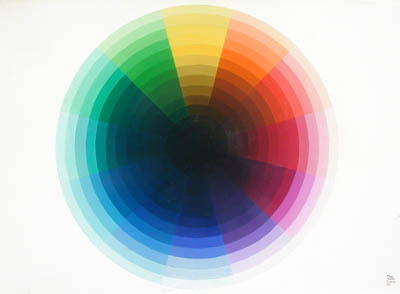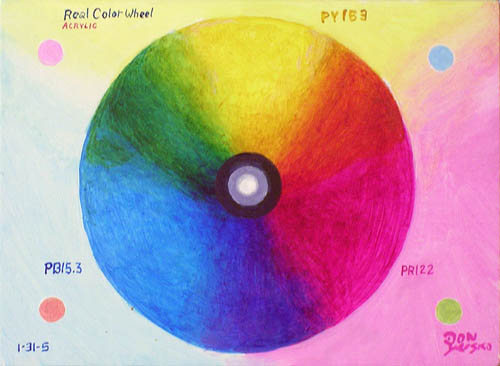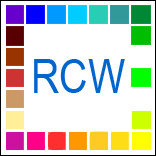Hi Mikee,
>Mikee Lapid wrote:
> Hi Don,
>
> I just happened upon your page the other day and, as an artist, I must say that it is a godsend for understanding the mixing of pigments!
>Thank you.
>
>
> What I would like to ask you tho is when and how you developed your theory?
>
Here is the Original RCW.

This is the original RCW was painted in 1995, Number 816, with acrylics.
It is the first pigment colorwheel with yellow, magenta and cyan as the primary colors, yellow darkening to brown, cyan darkening to ultramarine blue and all color complements mixing to a neutral dark.
The RGB computer colorwheel matched my pure colors but not the way they got dark. The RGB/CMY color wheel, as this one below, gets darker adding black (subtracting light).

I like to have yellow on top of my color wheel so I call it YMC not CMY. Read Red Right...
RGB/YMC won't work in pigments, black adds a green looking shade to each color. That's why HandPrints colorwheel plotting is off. Their plots are noted on this page.
http://www.realcolorwheel.com/colorwheel.htmI traced the element of each color with it's crystal and matched the crystals progression to dark. This would work for artists. Something that had never been done before. At that time, and still today in our teaching system, red, yellow and blue were considered the primary colors. I always knew this wasn't true, it never worked for me, how could it be true. All the reference books said it was. I was out to rock the world.
By 1997 some started to believe in me, by 1999 I was getting recognized.
http://www.realcolorwheel.com/testimonials1999.htmI was in the Advertising field until 1972, so I learned CYMK color.
In 1976 I started painting on location in Maui, Hawaii, full time.
Every painting had a set of notes, how I did it, what I learned while doing it. There were a lot of color notes.
I never used the pigment black, but made my darks using my complementary colors. I knew magenta was a primary color along with yellow and cyan. Magenta and green made my afternoon darks, dark yellow (brown) and ultramarine blue made my morning darks, while red and cyan worked toward the evening time.
It took a lot of testing to find the correct pigments, Liquitex helped by having the correct magenta, PR122, although they called it Acra Violet back then. Grumbacher had Thalo Blue PB15. Thalo Blue (cyan) and Thalo Green were discovered while I was in college in 1960. Today there still is a slight problem, no one is tubing the correct transparent yellow. It's out there.. the only supplier of it is Zecchi in Florence and Sennliair, I bought it dry and made my own tube colors.
<update, by 2006 most manufactures have some sort of transparent yellow>

Transparent yellow and transparent cyan make the perfect green, just like Phthalocyanine green Y/s.
Here is a 5" traveling, printable RCW to print out.
The full course CD includes a Laminated 5" RCW. On the CD ($35) are the 5", 8", 11" and 32" printable versions. They are all available as laminated hard copies, $10, $20, $30, $200. Kinko's makes a big price jump after 11x17 gloss paper.
http://www.realcolorwheel.com/orderpage.htmHere is your free 5" Real Color Wheel for a high quality CMYK tiff print out, Set your printer for 150 dpi.
http://www.realcolorwheel.com/RCWcmyk5_5in150dpi.tif.zipIt will take 5 minutes download on a dial-up.
Here is the RCW back copy only with pigment matching information.
http://www.realcolorwheel.com/rcwbk475350dp102004gifWeb.gif.zipI have a laminated CMYK 5x5 RCW printed with heat based permanent inks with the pigment colors printed on the back for $10.
Otherwise the color pigments are on this site.
http://www.realcolorwheel.com/tubecolors.htmThe full Real Color Wheel Painting on Location course site is on CD for $35 and includes the laminated 5x5 inch Real Color Wheel matching pigments printed on the back. The CD is always current and inclusive.
This link (also in the course) is to an interactive RCW describing all the colors.
http://www.realcolorwheel.com/tubecolors.htmFor a link to opposition (complement) colors.
http://www.realcolorwheel.com/complementsneutral.htmHere is a link to my site tree and full online color course free.
http://www.realcolorwheel.com/sitetree.htmIt's really nice to know what colors neutralize any other color you see. Shade any color naturally with out adding black pigment. I know it sounds to good to be true, but it is.
Here's page that has the pigments with the RCW numbers to match each color section.
http://www.realcolorwheel.com/mypigments.htmThis is how and why the RCW color wheel works.
In omnipresent lighting, shade lighting or in bright sunlight, daylight will give these results.
Take the red tomato and it's shade/shadow color.
The shade color of an object is always the opposite of the most saturated local color. The shadow color of a red tomato is cyan, red and cyan mix a neutral dark, that's the basis of the tomato's shadow.
Other colors may influence it by their approximation or reflection but that will not change the basic shadow color.
This holds true for every color object there is.
Red and green, yellow and purple, blue and orange are opposite only on the INCORRECT Red-Yellow-Blue color theory you were taught. They do not mix neutral darks.
This color wheel is based on the similarities between elements, crystals, chemicals and pigments. Crushed crystals are pigments, elements represent colors and chemical colors have the same color paths as both.
The yellow crystal becomes dark brown. Do you have any pigment colors that are duel-tone in this fashion? Nickel complex is a chemical name for one of these colors, Indian yellow. It makes the primary painting triad to dark. Just know that brown (dark yellow) and ultramarine blue (yellow's opposite) are complements that represent the yellow and blue opposition. Primary cyan gets darker by adding it's opposite red, green is opposite magenta.
The sun in the morning, when it is the brightest yellow, has blue shadows, when it's red at evening it has dark cyan shadows. Both are complementary sets of colors.
This page is about chemical colors and their color paths.
http://www.realcolorwheel.com/RCWDS.htmFor the crystals and elements of color, go here.
http://www.realcolorwheel.com/crystal.htmAloha,
Don Jusko
>
> The reason I ask is that I am editing an article on Wikipedia about color theory (
http://en.wikipedia.org/wiki/Color_theory) and the information is somewhat dated. Along with adding historical mentions of the development of the color wheel, I would like to mention and include your color wheel in the article with your permission.
>
I would be happy to have your link, you may use any image and any information you would like. I'm happy you are changing from red, yellow and blue being the primaries.
In the Color and Painting Course I have a main page called Final.
http://www.realcolorwheel.com/final.htmThere I have traced color from the B.C. era to today.
Noting when each new pigment color was discovered and which artist first used it.
Elements are physical color, shown in their crystals and making pigment with their oxides, crystals and derived chemicals.
>
> Could you also recommend some books or sources (online or otherwise) that discuss the flaws of earlier color theories and what has been done recently to correct them?
>
In "Final" I have all the color theories of the past listed, dated and their flaws noted, search the term Color Theory. You may find the term Paint Wars interesting also, it follows the media used through out time.
http://www.realcolorwheel.com/final.htmThis link will show the errors of the theory currently taught in all US schools as specified by their States School Standards.
http://www.realcolorwheel.com/newcolorwheel.htmI would like to help you however I can, the most important thing is to teach correct color and change the way we all have been taught.
The next most important issue is to have the manufactures of paint use the chemical term and the Pigment Index Name on each tube of paint. Artists have been taken advantage of for far too long in the name of free trade.
Stay in touch, I hope you get to follow the links.
Aloha,
Don Jusko
>
> Thanks for your help!
>
> Sincerely,
> Mikee Lapid
>
> -----
> Michael Lapid
> San Francisco, CA
>

 Home
Home

 Help
Help

 Search
Search

 Login
Login

 Register
Register

 Broadcast Message to Admin(s)
Broadcast Message to Admin(s)

 « Home
« Home  ‹ Board
‹ Board  Top of this page
Top of this page 
 Pages: 1
Pages: 1

